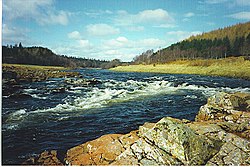
Back نهر دى (نهر) ARZ Ды (басейн Паўночнага мора) Byelorussian Дий (река) Bulgarian Dee Catalan River Dee (suba sa Hiniusang Gingharian, Scotland, Aberdeen City) CEB Dee (Aberdeenshire) Czech Ди (Çурçĕр тинĕс) CV Afon Dee (Swydd Aberdeen) Welsh Dee (Aberdeenshire) Danish Dee (Nordsee) German
| River Dee | |
|---|---|
 The River Dee at Potarch which is between Aboyne and Banchory | |
 The north east of Scotland showing the location of the Dee | |
| Native name | Uisge Dhè (Scottish Gaelic) |
| Location | |
| Country | Scotland |
| County | Aberdeenshire |
| Physical characteristics | |
| Source | |
| • location | Wells of Dee, Braeriach, Cairngorms |
| • elevation | 1,220[1] m (4,000 ft) |
| Mouth | |
• location | Aberdeen |
• coordinates | 57°08′32″N 2°04′02″W / 57.1422°N 2.0673°W |
| Length | 140 km (87 mi) |
| Basin size | 2,100 km2 (810 sq mi) |
| Discharge | |
| • location | Aberdeen |
 | |
The River Dee (Scottish Gaelic: Uisge Dhè) is a river in Aberdeenshire, Scotland. It rises in the Cairngorms and flows through southern Aberdeenshire to reach the North Sea at Aberdeen.[2] The area it passes through is known as Deeside, or Royal Deeside in the region between Braemar and Banchory because Queen Victoria came for a visit there in 1848 and greatly enjoyed herself. She and her husband, Prince Albert, built Balmoral Castle there which replaced an older castle.[3]
Deeside is a popular area for tourists, due to the combination of its scenery and historic royal associations.[3] It is part of the Cairngorms National Park, and the Deeside and Lochnagar National Scenic Area.[4] The Dee is popular with anglers and is one of the most famous salmon fishing rivers in the world.[5]
The New Statistical Account of Scotland attributed the name Dee as having been used as early as the second century AD in the work of the Alexandrian geographer Claudius Ptolemy, as Δηοῦα (=Deva), meaning 'goddess'. This indicated the river had divine status in the beliefs of the ancient inhabitants of the area. There are several other rivers with the same name in Great Britain, and they are believed to have similar derivations,[6] as may the Dee's near neighbour to the north which is the River Don.[citation needed]
- ^ Cite error: The named reference
watsonwas invoked but never defined (see the help page). - ^ Chisholm, Hugh, ed. (1911). . Encyclopædia Britannica. Vol. 7 (11th ed.). Cambridge University Press. p. 921.
- ^ a b "Royal Deeside". Visit Scotland. Archived from the original on 1 March 2018. Retrieved 7 February 2018.
- ^ Cite error: The named reference
sitelinkwas invoked but never defined (see the help page). - ^ "River Dee - Angling". River Dee Trust. Retrieved 7 February 2018.
- ^ "The New Statistical Account of Scotland, pp. 3-4". William Blackwood and Sons. 1845. Retrieved 28 February 2018.